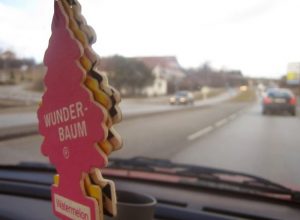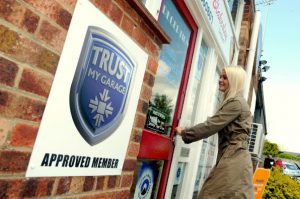Published on: 04/07/2020
Although many vehicles now offer in-built technology such as sat-nav, upgraded sound systems and changeable cabin lighting options, motorists can still opt to adapt their in-car experience to suit their needs and preferences.
The range of technology on offer for drivers to put into their vehicle is wide-reaching, but it is key for motorists to ensure they have correctly installed, positioned or integrated their add-ons to their motor – and to have notified the proper authorities where necessary.
If you’re looking to add some additional tech or equipment to your vehicle’s cabin, the Trust My Garage blog is here to help to ensure you comply with the rules of the road – read on to find out more!
Dashboard Cameras
Commonly known as “dash cams”, these in-car cameras have been popularised as a form of authenticity for recording road incidents and accidents. For proper installation, a dash cam must be fixed behind the rear-view mirror to ensure it doesn’t obstruct your view while capturing both lanes of the road ahead.

Once attached as per the manufacturer’s instructions, a power lead from the dash cam can then be carefully fitted around the edge of your windscreen to the dashboard, ensuring your view of the road remains perfectly clear of wires and cables. If your vision is impaired in any way by your dash cam, your vehicle insurer may refuse to pay out if you are involved in an accident.
As well as potential insurance issues, driving with any obstruction on your windscreen which could limit your field of vision may land you a £100 on-the-spot fine, as well as three penalty points on your driving licence. If your case goes to court, you could also be charged with a maximum fine of £1,000.
Satellite Navigation (Sat-Nav)
UK laws around sat-nav placement are not as specific as laws in place for other technology, such as mobile phones, but vehicle installation warnings advise that your sat nav shouldn’t:
- Interfere with vehicle operating controls or obstruct a driver’s view of the road
- Be placed in front of or above any airbag
- Be positioned where it could distract a driver if it falls from the windscreen
If you travel abroad with a removable sat-nav, before using it you should always check local laws to see if there are specific rules in place – for example, in France it is illegal to have anything in your vehicle that warns you of traffic enforcement camera locations.

When installing a sat-nav device, you should ensure first that the driver’s seat is in the same position as it would be when driving, as placement while sitting in a different position can affect visibility while on the road. You should try to mount your sat nav low down on your windscreen to the far right to maximise your view of the road. If this isn’t possible, opt for the lowest point in the middle of the windscreen.
If you decide to use a mobile phone as a sat-nav alternative, remember you cannot touch it while the vehicle’s engine is running and the keys are in the ignition; this breaks UK laws and can leave you subject to a £200 fine and six penalty points on your licence. Some motorists find a phone holder positioned in their vehicle’s vents helpful, as they can see the screen for directions without having to touch the handset.
Air Fresheners
Much like dash cam rules, air fresheners which dangle from your vehicle’s rear-view mirror can leave you subject to a fine of up to £1,000 and three penalty points on your licence. The Highway Code outlines that “windscreens and windows must be kept clean and free from obstructions to vision.”

It may seem extreme that an air freshener could be the main factor behind a fine, but if it contributes to a lack of vision which leads to a crash, you could be charged.
Windscreen Chips or Cracks
Windscreen chips are an almost-inevitable factor of driving, and in major cases can even lead to an MOT failure if left unattended.
In the driver’s line of vision, a chip or crack more than 10mm across is enough to fail an MOT. For reference, that’s slightly less than the size of a 5p coin. In other areas of the windscreen, if the damage is larger than 40mm (4cm), the vehicle can also fail its MOT.

If you are stopped by the police with either of these issues you could get a fixed penalty notice fine. If you crash your vehicle because you couldn’t see properly through a chip or crack in your windscreen, then you can be charged with driving without due care, and attention and potentially have your insurer refuse to pay any claims.
Many insurance policies can repair windscreen chips or replace cracked windscreens at a reduced cost. If this applies to your policy, details of the service provider your insurance company uses will be provided within your policy documents. You can make a note of the number for windscreen-related claims and keep it handy in case you get a chip and need to contact the repair company.
Keeping your Vehicle Safe and Roadworthy
To ensure you’re keeping your vehicle’s cabin safe, you should evaluate for any risks to your view whenever you are in your vehicle. Always fit any new technology legally and as per the manufacturer’s instructions, do not touch your mobile phone handset while you are driving and take time to ensure your view isn’t obstructed by any items in the cabin, or chips and cracks in your windscreen.
When it comes to technology in your vehicle, the Department for Transport (DfT) have said: “Vehicles have become inherently safer with more warning systems alerting the driver to maintenance issues and growing safety focused automation and driver assistance systems. At the same time advances in car infotainment systems and mobile phone technology mean that there are increasing sources of potential distraction for drivers.” Their concerns are that infotainment and mobile phones are leading to a failure to reduce road casualties in the UK.
If you’re concerned about any aspect of your vehicle’s safety, you can visit your local Trust My Garage member and ask them to check your vehicle is safe and roadworthy. You can even find your nearest member online and read reviews from other customers to make sure you get a service to suit your needs.
More about Trust My Garage
Trust My Garage is a collection of Britain’s trusted local garages – each one different and all dedicated to the highest standards of skill and personal service.
All garages in Trust My Garage are members of the Independent Garage Association (IGA), which is part of the RMI, one of Britain’s oldest motor trade organisations. IGA members are true professionals who have to comply with a strict code of practice.

Every customer of all Trust My Garage members can rely on using a nationally recognised brand to help you and your vehicle get the best value service for you and your vehicle. If you want to find out more about Trust My Garage, visit our website, like us on Facebook and follow us on Twitter!
Leave a Reply